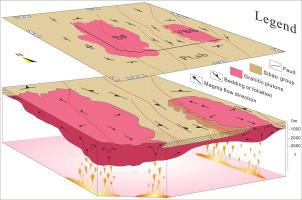Precambrian Research ( IF 3.8 ) Pub Date : 2020-12-21 , DOI: 10.1016/j.precamres.2020.106054 Chaolei Yan , Liangshu Shu , Yan Chen , Michel Faure , Zuohai Feng , Mingguo Zhai

|
The Neoproterozoic S-type granitic plutons, distributed along the suture zone of the Yangtze and Cathaysia blocks, play an important role in the tectonic evolution of the Jiangnan Orogeny. However, few studies had focused on the scientific issues on the physical construction process of these plutons, therefore, we carried out multidisciplinary approaches on the Sanfang and Yuanbaoshan plutons in the western Jiangan Orogenic Belt to figure out the construction mechanism of these plutons. Zircon Hf and U-Pb dating indicates that the magma, originated from the crustal partial melting, was crystallized at ca. 830 Ma. Field investigation shows that the plutons are dome shaped, and the inclinations of bedding/foliation of the country rocks, the Sibao group, gradually decreases away from the contact zone with pluton boundaries. A top-to-the–E kinematic sense was observed in the eastern margin of the Yuanbaoshan pluton. Both the textural analysis and AMS measurement reveal primary magmatic and secondary general top-to-the-W/NW post-solidus fabrics. The Bouguer gravity modeling reveals that the feeder zone probably locates in the southern part of each pluton and these two plutons are connected at depth. According to the primary magmatic fabric patterns, deep geometric shape as well as structural features of the country rocks, we propose that crustal partial melting magma probably initially intruded into the pre-existing mechanically weak (fold/fault) zone of the Sibao group, and meanwhile laterally and upward accreted to progressively construct the dome-shape plutons. The intrusion of ca. 850–820 Ma S-type granites in the Jiangnan region possibly marked the latest stage of the Jiangnan Orogeny. However, the timing and mechanism of the post-solidus deformation are not well constrained, the proposed interpretations remain hypothetical yet.
中文翻译:

华南江南造山带新元古代S型三方元宝山花岗岩体构造机理:地质观察,年代学,AMS和布格重力模型的启示
沿扬子和华夏地块的缝合带分布的新元古代S型花岗岩体在江南造山带的构造演化中起着重要作用。但是,很少有研究针对这些小行星的物理构造过程的科学问题,因此,我们对江安造山带西部的三方和元宝山小行星进行了多学科的研究,以弄清这些小行星的构造机理。锆石Hf和U-Pb测年表明,地壳部分融化产生的岩浆在约50℃时结晶。830毫安。野外调查表明,这些云母呈圆顶状,并且乡村岩石(四宝族)的层理/页岩倾角逐渐远离具有云母边界的接触区。在元宝山岩体的东缘发现了从上到下的运动学意义。质地分析和AMS测量都揭示了主要的岩浆和次要的从顶部到底部的固结后织物。布格重力模型表明,进料区可能位于每个岩体的南部,这两个岩体在深度上是相连的。根据原始岩浆构造模式,深部的几何形状以及乡村岩石的结构特征,我们提出地壳部分熔融岩浆可能最初侵入了四宝族早已存在的机械弱(褶皱/断层)区域,并且同时侧向和向上吸积逐渐形成圆顶状的聚积体。入侵ca。江南地区的850-820 Ma S型花岗岩可能标志着江南造山运动的最新阶段。但是,固结后变形的时间和机理并没有得到很好的约束,所提出的解释仍然是假设的。


























 京公网安备 11010802027423号
京公网安备 11010802027423号